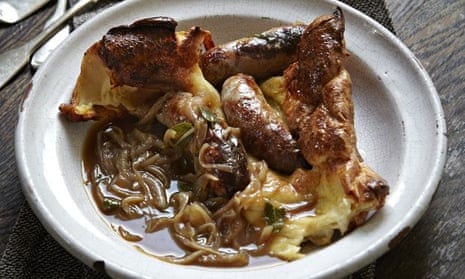If you listened to the Today programme on Tuesday morning, you may have heard it (try to) revive that old saw about there being a distinct north-south divide in food. Inspired presumably by Christmas sales data from Amazon showing that while Yotam Ottolenghi’s latest cookbook, Plenty More, was the sixth-bestselling gift in London – it did not make the wider UK top 10 – the Today presenter Justin Webb asked: “Are we one nation when it comes to food, or do we have marked regional tastes, with the more exotic foods enjoyed in the wicked fleshpots of London perhaps and the rest of us sticking to steak ’n’ chips?”
If Webb sounded tentative, little wonder. Because never has this perceived taste gap between, say, Manchester and London, sounded more outdated. If not Ottolenghi’s chargrilled squash with brussels sprout salsa, home cooks up north – like many of the region’s chefs – are likely to be cooking something equally interesting for their tea tonight. In fact, referring to it as tea, not dinner, may be one of the few true north-south food divides that still exists.
Of course, there is a distinctive northern cooking tradition: a repertoire of dishes such as Lancashire hotpot and potted Morecambe Bay shrimps that grew out of a specific climate, the abundance of key ingredients and the physical demands put on an industrial workforce – what, in France, they would call terroir.
Poorly paid, hard graft demanded pie and mushy peas, black pudding, tripe, liver and onions, Cumberland sausage and plenty of cheap carbs on the table at every meal. That is why the north has such a range of subtly different breads: stotties, oven bottoms, barm cakes.
Naturally, you can still eat pease pudding in Newcastle, pasty and black peas in Bolton, dripping-cooked fish and chips in Yorkshire (tip: try 149 in Bridlington). These foods echo down the ages. Although, significantly, many such delicacies have needed to be revived from near extinction. Nigel Haworth, chef-owner of the Michelin-starred Northcote near Blackburn, whose Ribble Valley Inns group does a fine line in toad-in-the-hole and sticky toffee pudding (a Cumbrian invention), is one of a number of high-profile chefs who have helped the north rediscover its historic dishes.
Whatever their current popularity, however, those traditional northern dishes exist happily within a wider food culture that is as globalised and open to new ideas as any on the planet. Are exotic ingredients as readily available up north as they are in London, the Today programme asked Ottolenghi? As he pointed out, Tesco sells pomegranate seeds, so obviously they are. But in many different, fragmented ways, such cross-cultural pollination has been going on up north for decades. The Chinatowns in Manchester and Liverpool, the curry hotspots in Bradford and Rusholme, and the food shopping available around them, have always exerted a cosmopolitan influence on the region. I have a mate whose mum used to regularly cook okra curries in the 1980s. That was rare, but it was happening.
True, up until very recently, in terms of its dynamism, diversity and providing reliable quality, the northern restaurant scene lagged way behind London, and the capital still kickstarts trends in the way that the north is only just beginning to. However, Leeds, Manchester and Liverpool are catching up fast. From the headline-generating Michelin ambitions of, for instance, Manchester House or the French, to superlative “dude food” (Honest Crust or Dough Boys’ pizzas; Patty Smith’s or Free State Kitchen’s burgers), we lack nothing, and are beginning to innovate concepts – most notably, the marriage of Gujarati food and craft beer at Leeds’ Bundobust – which are setting the bar nationally.
The reasons why are complex, but a new, knowledgeable and enthusiastic generation of diners up north is now fuelling a mini restaurant boom. Credible London independents are expanding northwards (Hawksmoor, Manchester; MeatLiquor, Leeds), and even in something as relatively niche as tapas – Lunya and Salt House in Liverpool, the forthcoming Iberica and El Gato Negro in Manchester – the region now has a choice of restaurants as authentic as anything in Soho.
In fact, rather than a north-south divide, the bigger issue may soon become one of bland repetition. Historically, pop culturally, Britain’s cities tended to have USPs – in music, the arts, football, nightlife – but increasingly they look like interchangeable, clean-cut hubs of bright, shiny consumption (usually of food and drink). We may be eating better, but in the process are we losing local colour?
